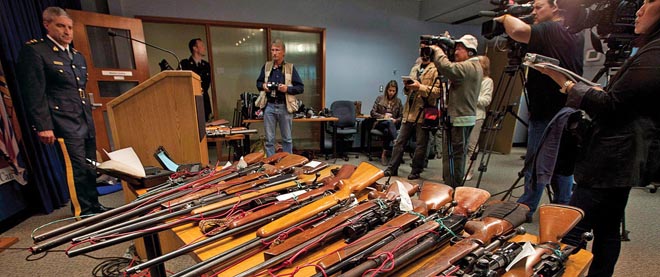Conservatives’ claim to curb illegal guns falls flat
There are cracks in the Harper government’s claim that it has stepped up the fight against gun smugglers
JONATHAN HAYWARD/CP
Share

As Americans debate their culture of guns with unprecedented intensity, concern in Canada about the spillover of firearms across the border might be expected to heat up too. Even before the school-shooting carnage at Newtown, Conn., which prompted U.S. President Barack Obama to propose a raft of politically contentious new gun-control measures, Canadian federal politicians regularly talked tough about the scourge of U.S. handguns turning up on Canada’s city streets. Public Safety Minister Vic Toews may have dismantled the domestic gun registry, but he has also made a point of publicly praising Canadian border officials for “vigilance in detecting and disrupting” gun smuggling. And Justice Minister Rob Nicholson declared, in the wake of a fatal shooting in Toronto last summer, “We’ve cracked down on the importation of guns into this country.”
But measurable evidence of that crackdown, or of any extra spending targeted at stopping guns from crossing the border, is hard to come by. The Canadian Centre for Justice Statistics, a branch of Statistics Canada, compiled a decade’s worth of data for Maclean’s on weapons trafficking cases that made it to court. From 2001 to 2011, the latest figures available, the centre’s data show no sign of any increase in the number of illicit gun dealers hauled into court and successfully prosecuted. In 2001-02, judges handed down 56 guilty verdicts to criminals who had illegally sold weapons, mostly guns; in 2010-11, 50 were found guilty. Over the 10 years reviewed, the annual number of convictions bounced around from 40 to 57. Most years, about the same number of charges were withdrawn after being brought to court. (Of cases pursued to a final verdict, however, very few ended in acquittals.) Overall, the stats show little change in the flow of charges laid and criminals convicted since the Conservatives came to power in 2006.
A consistent, modest caseload suggests any talk of a crackdown on gun smugglers or those who peddle handguns in Canadian cities might be overblown. It’s not as if Ottawa has thrown more money at the problem. Despite tough-on-crime messaging from Toews and Nicholson, the federal budget for combatting black-market guns has remained flat. The main program, a so-called horizontal initiative shared between the RCMP and the Canadian Border Services Agency, is called “Investments to combat the criminal use of firearms.” Established by the former Liberal government in 2004 with a five-year, $50-million budget, it’s been only slightly bumped since. The planned budget for 2011-12 was $11.3 million, although the RCMP topped that up with more than $2 million from its general funds to cover special costs, such as training and replacing some vehicles. By comparison, targeted federal funding for the RCMP’s investigations of marijuana growers and clandestine drug labs is slated to rise 33 per cent to $113 million in the five-year period starting this year, up from $85 million in the previous five years.
The RCMP’s National Weapons Enforcement Support Team helps police across the country investigate gun crime, including tracing the origin of seized weapons. Guns suspected of coming from the U.S. are routinely sent to Washington’s Bureau of Alcohol, Tobacco and Firearms. In 2011, the latest figures available, police sent 1,190 guns recovered in Canada to the bureau, down from 1,484 in 2007. But police caution against reading seizures as an indication of the prevalence of smuggled guns. “It is extremely difficult, I would even go so far as to say highly speculative, to say the number of guns seized is indicative of how many guns there are,” said Sgt. Lindsey Houghton of B.C.’s Combined Forces Special Enforcement Unit, a joint anti-gang squad of several police forces.
The unit made headlines last fall by cracking a gun-trafficking group working between B.C. and Florida. That story was accompanied by photos of an arsenal of firearms. Images like that can convey both the unwelcome notion that smuggled guns are a growing menace, and the reassuring one that efforts to intercept them are ramping up. In fact, the available data back up neither impression.